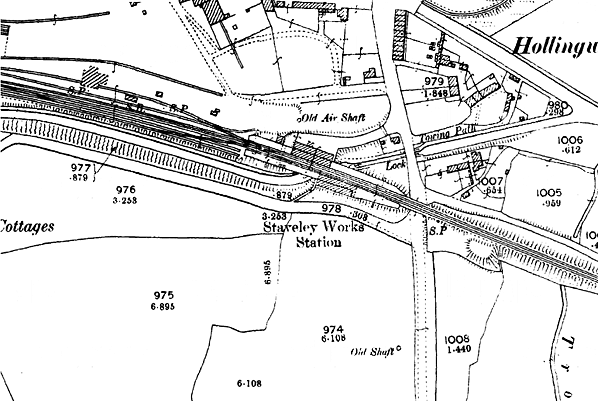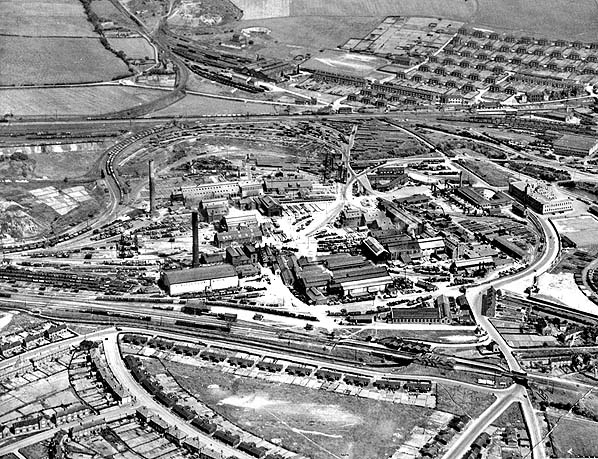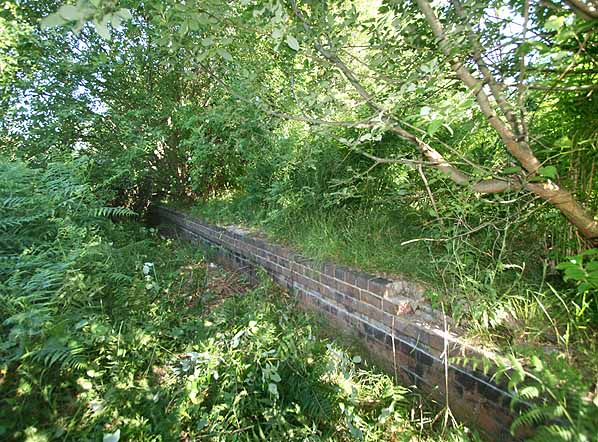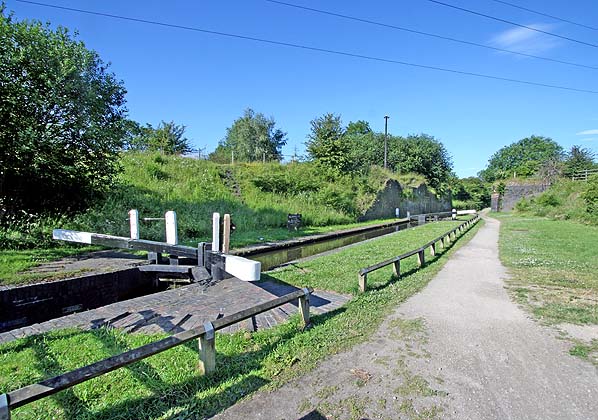Notes: The Chesterfield Canal, which was owned by the MS & LR, was extensively diverted in this area, with a new lock created. Parts of a large cinder tip, to the west of the station site, were removed to make way for the works, the material being used for embankments. Eight pairs of semi-detached ‘Railway Cottages’ were built in the area - these still survive at the north-western end of Station Road. Parts of the cinder tip (furnace slag) remained until comparatively recently at the bottom of the New Brimington area. In 1898 the tip was served by a small branch from sidings, which started immediately west of Staveley Works station. These sidings were created to tap into the business at Staveley Works.
Staveley Works was due to open with the Chesterfield branch on 1 June 1892 but was delayed until 4th June as the inspecting officer from the Board of Trade not being satisfied that work was sufficiently advanced at the station (and at Chesterfield)
 |
Staveley Works was a typical MS & LR station with two platforms each with a timber building. Each building had a substantial canopy stretching almost up to the platform edge. The booking office was located in the down side building. Unusually, the two platforms were linked by a pedestrian subway. The smaller 'up' platform building lost it's canopy, probably in the |
1950's while that on the down platform was built. The Chesterfield Canal ran underneath the station at its east end with a lock and lockkeeper's cottage sited on the east side of the station.
The station was located in an area of heavy industry, the largest employer in the area being the Staveley Works Foundry which provided much of the passenger revenue but this was not maintained after WW2. An analysis of passenger traffic carried out by BR for the week ending 19 August 1961 showed only 288 passengers using the station which closed on 4th Match 1963 when the Great Central local service was withdrawn.
The foundry had an extensive railway connected to the Great Central and the Midland Railway a short distance to the north but Staveley Works Station never handled much goods traffic, losing its goods service on 1st December 1955 although a private siding did remain in use after that date.
BRIEF HISTORY OF THE GREAT CENTRAL RAILWAY BETWEEN SHEFFIELD AND LONDON
The Manchester, Sheffield and Lincolnshire Railway (MS & L) was formed in 1846 by the
amalgamation of the Sheffield, Ashton-under-Lyne and Manchester Railway with two proposed
lines - the Sheffield and Lincolnshire Junction Railway and the Great Grimsby and Sheffield
Junction Railway; the SA & M had opened between Manchester and Sheffield Bridgehouses in
1845. The Manchester, Sheffield and Lincolnshire Railway ran between Manchester London Road
(now Piccadilly) via Penistone to Sheffield (the Woodhead route) and on to Brigg, Grimsby and Cleethorpes. A second line left the main line at Penistone and served Barnsley, Doncaster and Scunthorpe before rejoining the Grimsby line at Barnetby. The MS & LR opened a line from Sheffield Bridgehouses to Beighton for passengers on the 12th February 1849. Passengers going south and to London changed on to the ‘Midland’ line at Eckington. On 15th September 1851 a new station called Sheffield Victoria was opened a short distance to the south west of the Bridgehouses terminus which was retained as a goods depot.
In 1854, Edward Watkin became General Manager and then in 1864 chairman of the Company. Watkin's ambition was to build a rail link between the industrial heartland of Manchester and Sheffield, south to London and through a tunnel beneath the channel to reach Paris and the expanding markets of Continental Europe.
| In order to fulfil his ambitions, Watkin also became Chairman of the Metropolitan Railway who were in the process of extending their line northwards towards Rickmansworth and the South Eastern Railway connecting London with Dover. Initially, Watkin tried to convince other companies to build links with the MS & L allowing him to reach London but he was unable |
 |
to reach agreement and eventually was left with little option than to build his own line southward from Sheffield to reach the Met
In the 1890's the MS&LR began construction of its 'Derbyshire Lines', in effect the first part of its push southwards. Leaving its east - west main line at Beighton Junction, some 5 1/2 miles east of Sheffield, the line headed south through the Nottingham coal field with a branch line serving its new Central Station in Chesterfield. In July 1890 the MS&LR obtained another act to extend from Chesterfield to Heath creating a loop line. Work started on this new section, of some 4¾ miles, before construction on the original line was finished and opened in July 1893.
In 1893 the MS&LR obtained Parliamentary approval to extend this line to London (known as the ‘London Extension’. Construction of the 92 mile route started in 1895 and on 1st August 1897 the company changed its name to the Great Central Railway; it was the last 'main line' to be built until the Channel Tunnel rail link in 2003.
Due to its late construction, the company was able to take advantage of the latest technology including steam excavators. It was heavily engineered with viaducts and wide cuttings with a maximum gradient of 1 in 128; there were no sharp curves or level crossings which would ensure a fast service for both passengers and freight. Most of the stations on the ‘London extension’ were built to a standard design consisting of an island platform with the booking office located on the platform. All the stations were built on an embankment or in a cutting adjacent to a road bridge, with access via stairs from the middle of the bridge; only the larger intermediate stations like Rugby and Loughborough had street level buildings. Because Edward Watkin also expected his trains to reach Europe through a channel tunnel, the line was also built to a larger continental (Berne) loading gauge. The Great Central opened for coal traffic on 25 July 1898, for passenger traffic to a new terminus at Marylebone on 15 March 1899 and for general goods traffic on 11 April 1899.
 |
The new line was built from Annesley in Nottinghamshire to join the existing Metropolitan Railway which had now reached Quainton Road in Buckinghamshire, where the line became joint Met/GCR owned (after 1903), it returned to GCR metals near Finchley Road for the final section into Marylebone. In 1903, new rails were laid parallel to |
the Metropolitan Railway from Harrow to the junction north of Finchley Road, enabling more traffic to use Marylebone. Although the new line had now reached London, Edward Watkin was unable to fulfil his ambition as he was forced to retire through ill health.From the outset, the line had to compete with established north – south routes and the first train only carried a disappointing four passengers so the company had to work hard to win passengers from its rivals; with a well managed Advertising campaign and the introduction of a fast and efficient train service the companies fortunes slowly improved although it was never a match for its rival lines.
In the 1923 grouping, the Great Central became part of the London & North Eastern Railway which brought an increase in freight traffic from the south Midlands and south west England but the LNER's main north - south route was into London Kings Cross so the Great Central was always considered as a secondary route.
After nationalisation, the line became part of British Railways Eastern Region but was transferred to the London Midland Region in 1958. By this time the service was already in decline with the increasing popularity of the car and it was unable to compete with other north - south routes as the line passed through sparsely populated areas south of Rugby. Manchester to London express services were withdrawn on 2nd January 1960 leaving only three semi-fast trains a day and it came as little surprise when the line became the first main line to close in the Beeching era. Beeching considered that the Great Central was a duplicate route which could be sacrificed in favour of the Midland main line.
Many of the intermediate stations, including the Chesterfield loop closed on 4th March 1963 and long distance freight services were withdrawn shortly afterwards. Annesley Motive Power Depot (between Nottingham and Sheffield) closed on 3rd January 1966 and Nottingham Victoria closed on 5th September 1966 along with the remaining stations south of Rugby. The track was lifted between Rugby and Calvert leaving a diesel multiple unit (DMU) shuttle service operating between Rugby and Arkwright Street and the southern section of the line between Aylesbury and London Marylebone which still carried considerable commuter traffic. The northern section of the line between Sheffield Victoria and Woodhouse also remained open as this also formed part of the Sheffield to Lincoln line.
The line north of Nottingham remained in use until May 1968 serving the collieries at Annesley and Newstead and was eventually lifted in October/November 1969.
In 1968 the London Railway Preservation Society chose Quainton Road as its new base, the society being renamed as the Quainton Railway Society; this has now developed into the Buckinghamshire Railway Centre covering 25 acres. The Centre boasts one of the largest private railway collections in the country with numerous steam locomotives, many housed in the former listed trainshed from Oxford Rewley Road which was dismantled and rebuilt at Quainton Road in 1999/2000.
 |
The shuttle service between Nottingham and Rugby lasted until 3rd May 1969. As closure approached a group of railway enthusiasts got together to discuss the possibility of buying a section of the track to operate preserved steam locomotives. A steam service was reinstated between Loughborough and Quorn in 1973 and in 1976 Charnwood Borough Council agreed to |
purchase the land from BR and lease it to the railway for 99 years. Despite a shaky start, the Great Central Railway PLC are now operating throughout the year between their headquarters at Loughborough Central and a new station called Leicester North just inside the city boundary. The remaining track between Leicester - Rugby was lifted in early 1970.
North of Loughborough, the line remained open for freight traffic after closure to passengers in 1969 serving the gypsum mine at East Leake and the Ruddington Ordnance Storage and Disposal Depot south of Nottingham. This traffic ceased in the 1980's and the track north of Loughborough was mothballed by BR until 2000. In the early 1990's a group of transport enthusiasts set up the Great Central Railway (Nottingham) Ltd with the aim of redeveloping the derelict Ruddington Ordnance depot as part of a country park project. The depot was turned into the Nottingham Transport Heritage Centre (NTHC) and trains were run on a small length of line into the depot.
The NTHC's aim was to reinstate the remaining line into Loughborough where it joins the GCR
PLC thus forming a single 18 mile preserved line. In the 1990's NTHC obtained a loan to buy
the track from Railtrack. Gypsum traffic resumed in 2000 with up to two daily trains and revenue from British Gypsum is used to pay off the loan. Rushcliffe Halt has now been restored and in 2003 regular services were reinstated although passenger trains south of Rushcliffe Halt are limited to the second Sunday of each month as there is no station at Loughborough.
It is now both groups aim to reinstate two bridges, one over the Midland main line north of Loughborough, rebuild 300 yards of embankment and relay little more than a quarter of a mile of track. As well a 'bridging the gap' between the two preserved lines further long term proposals would see the line extended southwards to Leicester Abbey and northwards from Ruddington to join up with the Nottingham tram network and on to Nottingham city centre.
Sheffield Victoria closed on 5th January 1970 with the closure of the Woodhead route and trains from Lincoln were diverted into Sheffield Midland. Although the southern section of the main line remained open, it too was proposed for partial closure in 1986. Aylesbury was to remain open but all services would run into Paddington via Princes Risborough. Marylebone Station was due to close on 12th May 1986 but the station was eventually reprieved and the closure proposals were rescinded. Following rail privatisation in the 1990's, Chiltern Railways took over the route and in 2006 two new platforms were built at Marylebone on the site of the old daytime carriage sidings. The new platforms and partial resignalling of the station throat now make it possible to run 20 trains per hour in and out of the station.
| North of Aylesbury the track remains in place but is only used by waste freight trains to the landfill site at Calvert where a junction with the Oxford - Cambridge line remains in use. On selected days, usually bank holidays, special passenger services run to the Buckinghamshire Railway Centre at Quainton Road station. There are now proposals to extend the |
 |
passenger services northwards to a new station called Aylesbury Vale Parkway at the point where the line crosses the A41 near Berryfields Farm. This area is to be known as the Berryfields Major Development Area and will include park and ride facilities for Aylesbury.
With our motorway network now working at capacity there have been a number of proposals to reopen other sections of the Great Central main line and in 2006 Central Railway was formed to look into the feasibility of building a new rail link from central England to the Channel Tunnel which would include rebuilding part of the Great Central route south of Rugby reviving a 1990’s government proposal to reopen that section of the line as part of a fast rail link from Scotland to the Channel Tunnel.
Preservation group web sites: The Buckinghamshire Railway Centre, The Great Central Railway (steam service between Loughborough and Leicester North) & Nottingham Transport Heritage Centre (steam service between Ruddington and Loughborough)
Selected other web sites: The Transport Archive contains further detailed history of the Great Central plus a vast collection of 2344 'on line' photographs many ( the Newton Collection) taken during the construction of the London Extension. Chris Ward's Annesley Web site featuring numerous photographs of the Great Central around Nottingham and the Annesley Motive Power Depot. Great Central Railway through Leicester. Nigel Tout's web site with numerous photographs of the Great Central remains around Leicester and a series of archive photographs of the line. Bridging the Gap details ongoing work to reinstate the link between the two preserved lines. The Great Central Railway Society promotes an historical interest in the Great Central Railway.
Selected further reading: Great Central Memories by John MC Healey published 1987 by Baton Transport ISBN 0 85936 193 4 - heavily illustrated history of the London Extension. Great Central Then and Now by Mac Hawkins - published (2nd edition) by BCA 1992 ISBN 0 7153 9326 X , station by station photographic survey of the Great Central between Sheffield and London with numerous 'then and now' photographs. See also Sheepbridge & Brimington Station and construction of the Manchester, Sheffield and Lincolnshire Railway through Brimington by Philip Cousins. Published in St. Michael & All Saints, Brimington parish magazine. (Click here for full text). Tickets from Michael Stewart except 2066 Glynn Waite.
Click here to see a video of Staveley Works station and the adjacent lock on the Chesterfield canal in November 1986 (requires Adobe player or compatible).
Too see other stations on the Great Central Railway between Sheffield Victoria and Aylesbury click on the station name: Aylesbury, Waddesdon, Quainton Road (1st site), Quainton Road (2nd site)**, Calvert, Finmere, Brackley Central, Helmdon, Culworth, Woodford Halse, Charwelton, Braunston & Willoughby, Rugby Central, Lutterworth, Ashby Magna, Whetstone, Leicester Central, Leicester North***, Belgrave & Birstall, Rothley**, Swithland****, Quorn & Woodhouse**, Loughborough Central**, East Leake, Rushcliffe Halt**, Ruddington, Ruddington Factory Halt, Arkwright Street, Nottingham Victoria, Carrington, New Basford, Bulwell Common, Bulwell Hall Halt, Hucknall Central, Annesley South Junction Halt, Hollinwell & Annesley, Kirkby Bentinck, Tibshelf Town, Pilsley, Heath, Staveley Central, Renishaw Central, Killamarsh Central, Beighton (1st site), Woodhouse Junction, Woodhouse*, Darnall*, Sheffield Victoria & Sheffield Bridgehouses.
Chesterfield loop - Staveley Works, Brimington, Chesterfield Central & Grassmoor
* Station still open but included for completeness ** Station reopened by Great Central steam railway and Nottingham Transport Heritage Centre *** New station opened by Great Central steam railway **** Station planned and partially built but not opened |

works_old4.jpg)


works_old5.jpg)

works_old2.jpg)
works_old1.jpg)
works_old3.jpg)
works14.jpg)
works15.jpg)
works12.jpg)
works6.jpg)
works1.jpg)









works_old_thumb6.jpg)
works_thumb13.jpg)


works_thumb7.jpg)





 Home Page
Home Page